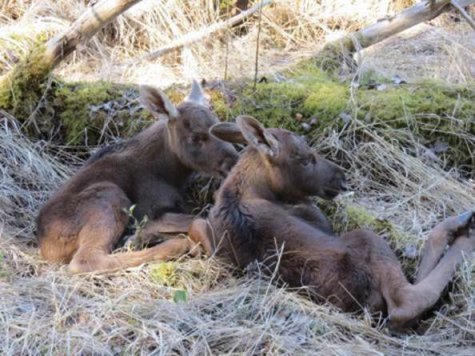Video recorded by Mats Kangur
Photo Jaan Mitt
Translation Liis
The adult knows what the calf will manage at its age
Elk (N America also Moose) Põder Alces alces
Elk cows started giving birth in Estonian forests in the last week of April, but the elk population will increase during the whole of May.
Young elk cows, a couple of years old, giving birth for the first time, usually have one calf. As the cows become older and when there is adequate food there may be two calves or in very rare cases even three.
The weight of the newly born may vary quite widely, in an interval of 6 and 16 kilos. The intrepid calves almost at once start to nibble at grass straws as supplement to the mother’s milk.
In case of danger they simply remain lying on the ground. Already at a few weeks old they run faster than humans and at three weeks they start to feast on young tree shoots.
Depending on its age an elk calf uses up to a couple of litres of milk a day and the elk cow suckles them until late autumn; by that time the calves already weigh clearly more than a hundred kilos.
In Russia elk farms have been kept for decades and of course the nutritional value of elk milk has been investigated, In May-June the fat content of the milk is 8-13 %, the protein content 12-16% and the amount from one elk cow is up to

2-3 days old elk calves from whom Jaan had to hurry away after photographing…
If you happen to come across an elk calf in the forest now it is wise to retreat at once. The cow often leaves the calves to rest; before the calves are enterprising enough to go along with their mother she comes to suckle them.
A lonely elk calf should not be regarded as an orphan or as abandoned. Large animals know their territory well, as well as the dangers there.
Shortly before giving birth the elk cow forces the young calves from the previous year that have spent the winter with her to start an independent life (the female simply drives the young ones off).
The year-old young elks must manage on their own from then onwards. Spring and early summer is precisely a time when inexperienced elks stray into communities – in the search for a suitable territory for themselves. They cross roads at night and only too often the still inexperienced animals cannot return to the familiar forest in the daytime dense traffic. They are stressed, lose their orientation and so all kinds of muddles and mishaps may occur as can be read in the newspapers from time to time.
Elk bulls grow antlers that are covered with soft skin. The antlers of the year-old elk bulls are unbranched so called “stick antlers“.


